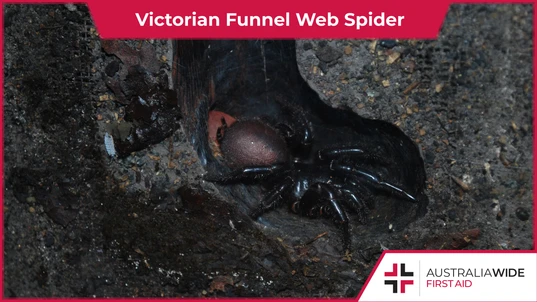The Victorian Funnel Web Spider

Bites and Stings

The Victorian Funnel Web Spider can be encountered on the outskirts of the Dandenong ranges. They are closely related to the Sydney Funnel Web Spider, Australia's deadliest arachnid.
The Victorian Funnel Web Spider can be found on the outskirts of the Dandenong Ranges in south-eastern Victoria. They are closely related to the deadly Sydney Funnel Web Spider, both in appearance and genealogy. Luckily, the Victorian Funnel Web Spider (Hadronyche modesta) has not been implicated in any fatalities or serious envenomations. In saying that, their bites can cause a generalised reaction.Habitat
The Victorian Funnel Web Spider is the only Funnel Web Spider found near Melbourne. They live in silk-lined burrows that they build in the ground or above the ground in ferns, stumps, or tree trunks. Their preferred habitats include urban areas, dry forests, wet forests, and woodlands.Appearance
Female Victorian Funnel Web Spiders can measure up to 3 cm long. They have a dark brown to black abdomen and a shiny black cephalothorax and legs. Male Victorian Funnel Web Spiders are similar to their female counterparts, though they only tend to grow up to 2 cm long. Likewise, their cephalothorax and legs generally have a polished lustre.Danger
Female Victorian Funnel Web Spiders are rarely encountered, as they only tend to leave their burrow to pounce on nearby insects and small vertebrates. Males are often encountered during late summer and autumn, when they leave their burrow to search for mates. Though they are not as aggressive or dangerous as their Sydney counterpart, Victorian Funnel Web Spiders can rear up when threatened. If bitten, you may experience headache, nausea, vomiting, and muscle pain.First aid for Funnel Web Spider bite
Victorian Funnel Web Spider bites should be treated in the same manner as a Sydney Funnel Web Spider bite. There are approximately 40+ varieties of large black spiders, so it is better to be safe than sorry:- Keep the casualty at rest and as still as possible to stop the venom from travelling through the body.
- Constantly observe and reassure the casualty.
- Follow DRSABCD and be prepared to perform CPR
- Apply the ‘pressure immobilisation technique’ (PIT):
If the bite site is on a limb, cover it with a wide heavy elastic bandage (10 - 15 cm wide).
Ensure the bandage is firm and tight, so tight you cannot easily slide a finger between the bandage and the skin.
Apply a second heavy elastic bandage. Start from the fingers or toes and wind up the limb as far as possible. Consistent coverage (overlapping half over half) and consistent pressure (firm but not cutting off circulation) are key to an effective PIT. - Immobilise the limb and joints with a splint, or use a sling if the bite site is on an arm. Keep the limb immobilised until the ambulance arrives.
Final thoughts
With their dark coloured abdomen and shiny black cephalothorax, Victorian Funnel Web Spiders are a scary sight in the Dandenong Ranges. Luckily, they are not as deadly or aggressive as their Sydney counterpart, though their bites should be treated with caution. To learn more about identifying and treating spider bites, book a First Aid course with Australia Wide First Aid today.
Originally published at
https://www.australiawidefirstaid.com.au/resources/victorian-funnel-web-spider
as part of the Australia Wide First Aid Articles Library









